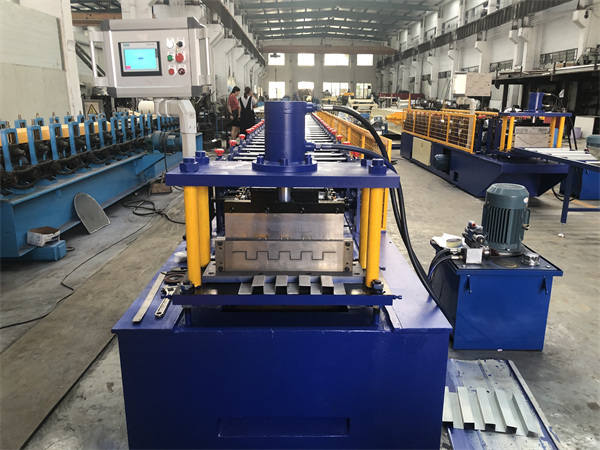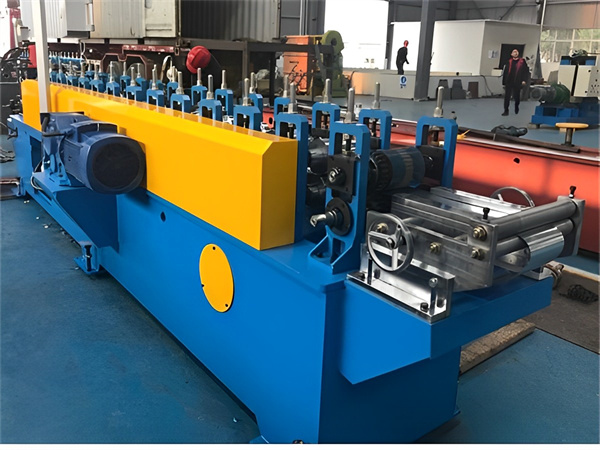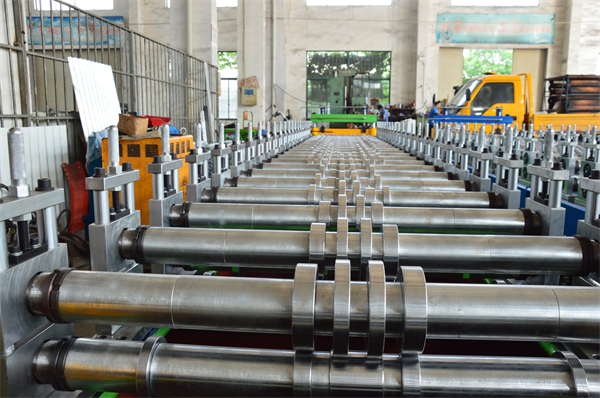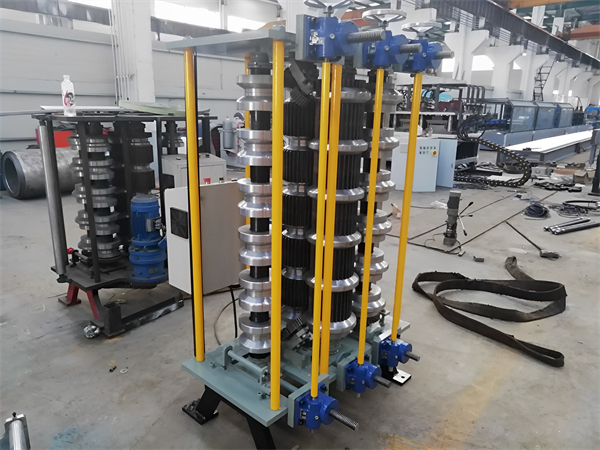water gutter roll forming machines are an essential part of any industrial building. They help channel rainwater runoff efficiently and prevent damage from water accumulation on roofs. Installation of high-quality water gutters ensures the longevity and performance of industrial buildings. The roll forming process allows manufacturers to create water gutters with tight tolerances and consistent quality. Here are some of the key industrial advantages of using roll formed water gutters:
High Production Speeds
The roll forming process is highly optimized for speed and efficiency. It is a continuous production method that can operate at speeds over 100 feet per minute. This is significantly faster than traditional manual gutter fabrication techniques. Roll formers produce lengths of finished gutters rapidly by passing flat strips of metal through a series of roller dies. Each die incrementally forms the sheet into the desired gutter profile. This automation allows roll forming machines to achieve production rates of over 5,000 feet per hour. The high speeds benefit industrial facilities by enabling rapid gutter deployment.
Konsistensi dan Akurasi
Roll formed gutters have a high degree of dimensional consistency and accuracy. The roller dies precisely shape the gutters to within tight tolerances of 1/32 of an inch. This level of precision exceeds manual fabrication methods. The repeatability of the automated rollers creates finished gutters with the exact same profile and dimensions. This consistency ensures proper fit and joining during gutter installation for industrial buildings. It also streamlines any replacement of damaged gutter sections.
Ideal for Large Production Runs
The roll forming process is ideal for producing large quantities of gutters rapidly. Switching between gutter profiles and dimensions is quick with adjustable roller dies. This versatility supports the mass production of gutters in long production runs. Manufacturers can use a single roll former to produce all the gutters required for the roofing needs of multiple industrial facilities. The large production volumes lower overall costs and speeds delivery times.
Range of Materials and Finishes
Roll formers support using a wide range of metals and finishing processes. Common gutter metals like aluminum and galvanized steel alloy can be roll formed. More specialty options like copper, zinc, and stainless steel are also formable for high-end applications. In addition to bare metal, manufacturers can apply protective and aesthetic finishes like paint coatings and baked enamels during the automated forming. This material and finishing flexibility allows industrial buyers to select the ideal gutter metal and coating for their buildings based on cost, performance, and longevity.
Engineering Consistent Strength
The incremental bending steps of roll forming create consistent material strength. The metals undergo controlled levels of cold working as they pass through the roller dies. This work hardening enhances the overall tensile strength of the finished gutters. It also avoids over-bending that can fatigue and weaken the metals. The automated process applies uniform pressure that improves strength without compromise. This reliable structural integrity prevents gutter failures or deformations after installation.
Kebutuhan Tenaga Kerja yang Lebih Rendah
Roll forming machines require very minimal labor to operate. Once set up and running, the automated formers can reliably produce high volumes of finished gutters unattended. This boosts overall efficiency and productivity while minimizing labor costs. Only a single operator oversees the roll former and performs periodic quality checks. Lower labor requirements mean industrial facility owners spend less on gutter fabrication and installation.
Minimal Material Waste
The continuous roll forming method avoids the higher material waste typical of cut-to-length gutter fabrication. Roll formed gutters have no end trim scraps or unused sheared leftovers. Manufacturers can produce any length of gutter needed by adjusting the run-out table length. This efficient material utilization lowers overall gutter costs for buyers and increases profitability for producers. Less waste also supports eco-friendly production.
Versatility For Design Options
Roll formers can produce a wide range of gutter types and designs. Adjustable roller dies support forming gutters of different sizes, profiles, and bottom contours. Multi-profile designs with decorative ribbing or fluting are possible. This versatility provides industrial architects and builders with ample design options to integrate gutters into the look of each facility. Unique gutter forms can match specific architectural styles like art deco, industrial, or postmodern.
Integration of Accessories and Features
The roll forming process can integrate useful gutter features and accessories directly into the gutter profile. Sheet metal strips for gutter guards or screens can be added during forming. Reinforcing hemmed rims and pre-punched outlet holes simplify installation. Decorative end caps and corner pieces can be attached downstream of the roller dies. This streamlines production by minimizing secondary fabrication and assembly steps.

Superior Corrosion Resistance
Roll formed metal gutters provide excellent corrosion resistance and longevity. The metals obtain enhanced corrosion protection from factory applied coatings versus field painting. Kynar-based finishes baked on during roll forming withstand UV exposure and industrial pollutants. Anodizing treatments improve aluminum’s weathering protection. Stainless steel resists rust and requires minimal maintenance. Durable coatings prevent unsightly corrosion that could compromise gutter function.
Ideal for Any Rainwater Runoff Volume
The high production rates and design versatility of roll forming ensure gutters can be fabricated for any size industrial building and rainfall volume. Manufacturers can fulfill orders ranging from small warehouses to large factories or institutional campuses. Heavier gauge metals withstand water loads from higher pitched roofs. Deep box or half-round profiles contain runoff from expansive roof surface areas. This scalability makes roll formed gutters an ideal drainage solution.
Quick and Easy Maintenance
Field maintenance of damaged roll formed gutters is quick and simple. Since all sections have the same specifications, installers can rapidly replace any dented or perforated portions. Consistent dimensions allow new gutter pieces to seamlessly integrate with existing sections. No specialized fabrication or bending equipment is necessary for repairs. Maintenance crews can pre-form replacement parts at their shop as needed. This facilitates speedy on-site repairs and lower repair costs.
Less Expansion and Contraction
Roll formed gutters experience minimal expansion and contraction issues. Longer gutter sections see less joint movement from temperature swings. The cold working of the metal stabilizes the crystalline structure and density. This reduces the tendency of thermal expansion that loosens gutter joints. Problematic expansion-related leaks are less likely. Industrial facilities experience better gutter performance through temperature extremes.
Higher Gutter Strength and Stiffness
Roll formed gutters gain significant increases in overall section modulus and lateral stiffness. The series of controlled bends in the forming process enhances the mechanical strength. The incremental bending cold works and hardens the metal without reducing ductility. This boosts resistance to damage from snow and ice loads or falling debris. Dents and punctures are less likely. The improved rigidity also ensures optimal gutter alignment and pitch are maintained after installation.
Reduced Leaks and Maintenance Needs
The combination of consistent sizing, precision fit tolerances, and increased strength minimizes leaks and drainage issues with roll formed gutters. There are fewer openings for water ingress at seams and connections versus site-fabricated gutters. Enhanced durability reduces damage from storms. This results in less required field maintenance. Facility owners spend less time and money on inspection, repairs, and replacement of faulty gutters.
High Radiation Resistance Properties
Industrial facilities processing radioactive materials require gutters made from metals with radiation resistance. Copper, stainless steel, and lead-coated carbon steel roll form well and provide protection from gamma rays and neutrons. Coatings like zinc also resist radiation embrittlement damage. Roll formed gutters avoid radioactive contamination while still shielding buildings and managing runoff. The automated process efficiently creates the specialized gutters needed by nuclear plants, research labs, and waste management centers.
Cost Competitiveness
Despite the high precision and material benefits, roll formed gutters remain very cost competitive with site-fabricated products. The speed and efficiency of automated roll forming results in per-foot part costs comparable to manual gutter fabrication. Larger manufacturers also obtain bulk pricing discounts on alloyed metals like galvanized steel. This combination of automated productivity and lower materials cost helps control overall gutter costs for industrial purchasers.
Minimal Environmental Impact
Roll forming lines require far less energy, space, and raw materials versus other gutter fabrication methods. The compact equipment footprint and high yield rates result in significant environmental advantages. Roll formed gutters also support green construction practices. Recycled content metals like aluminum and polymer finishes minimize ecological impacts. This sustainability helps industrial companies meet internal sustainability goals and qualify for LEED building certification.
Common Gutter Types Produced by Roll Forming
There are several common gutter profiles that can be produced using the roll forming method. Here are some of the most popular gutter types used for industrial buildings:
Talang Air Gaya-K
K-style is the most common and economical gutter type. It has a flat back and a rounded front. The flat back allows direct attachment to the roof edge or fascia. The curved front helps water flow and minimizes debris accumulation. K-style gutters come in 4-inch up to 8-inch widths.
Talang Setengah Bulat
Half-round gutters have a curved U-shaped cross section. The round bottom surface allows superior water runoff. Half-round gutters have high capacity and strength. They require the use of gutter hangers for installation. Available sizes range from 4 inches up to 8 inches.
Talang Kotak
Box gutters have a rectangular enclosed shape with four flat sides. The flat bottom optimizes water flow. The tall sides allow higher water volumes. Box gutters require building-integrated support for installation. They are ideal for flat commercial roofs. Common sizes range from 5 inches by 5 inches up to 12 inches by 12 inches.
Bead Gutters
Bead gutters feature a rounded bottom with angled sides that terminate in a small bead rim. The bead rim provides ornamental detail. Bead gutters install with either hidden hangers or fascia brackets. They come in 4-inch to 6-inch sizes.
Copper Gutters
Copper gutters have an upscale look and long service life. They are available in half-round, box, and K-styles. Copper naturally patinas to a greenish color over time. Copper is also naturally algae and mildew resistant. These gutters are common on historic industrial buildings.
Ogee Gutters
Ogee is a decorative gutter style with an S-shaped profile. It has a flat back, curved bottom, and flared sides. Ogee is a popular choice for more architecturally distinguished industrial facilities. It provides a clean, distinguished appearance.
Commercial Box Gutters
Commercial box gutters are large, heavy-duty systems that attach directly to the roof edge. They handle huge volumes of water from expansive roofs. Commercial box gutters are deep enough for walkways or maintenance access. They are common on factories, warehouses, and large retail stores.

Key Factors When water gutter roll forming machine
There are several key factors industrial purchasers should consider when selecting and specifying roll formed water gutters:
Gutter Profile Type
The shape and contours of the gutter impact performance, capacity, and aesthetics. Choosing the right profile is essential. Half-round and box styles have higher water handling capability. Decorative profiles like ogee provide architectural enhancement.
Jenis Bahan
Common gutter metals each provide unique benefits. Aluminum offers durability and light weight. Galvanized steel is economical and can be painted. Copper is eye-catching and long-lasting. Consider metals approved for special uses like stainless steel for coastal environments.
Color and Finish
Specialty finishes can enhance aesthetics and durability. Match architectural details with corresponding colors. Consider long-lasting, protective coatings like Kynar-based PVDF paints and baked-on enamels.
Rainfall Volumes
The amount of roof runoff the gutter must handle depends on building size and average rainfall. Carefully calculate required gutter capacity based on regional weather data to avoid inadequate drainage.
Roof Edge Considerations
Factors like roof overhang depth, fascia height, and eave design impact gutter placement and attachment. Check for sufficient clearance between the roof edge and gutter.
Structural Strength Needs
Gutter gauge (thickness) must withstand snow loads and other structural loads without deformation. Heavier gauge metals provide added durability for gutters with long spans.
Persyaratan Instalasi
Determine the optimal gutter hanging or roof edge mounting method. This affects gutter profile selection and bracket requirements. Consider any drainage connections needed.
Sustainability Requirements
Many facilities pursue LEED green construction certification or have internal eco-friendly building standards. Ensure the gutter materials and finishes meet minimum recycled content and sustainability goals.
Pertimbangan Biaya
Compare overall cost between gutter profiles and material types based on durability, life cycle value, and required maintenance. Avoid choosing solely based on lowest upfront cost. Analyze total long term cost of ownership.

Benefits of Working with Established Roll Forming Companies
Choosing an experienced gutter manufacturer is just as important as choosing the right gutter metal and profile. Here are key benefits of partnering with a reputable roll forming company for your industrial gutter projects:
Proven Reliability and Quality
Established companies have long track records of producing high quality roll formed gutters from quality-controlled metals. Strict quality assurance and testing ensures consistently reliable gutter production.
Wide Material and Profile Options
Experienced producers offer an extensive selection of gutter profiles across multiple material types. This enables buyers to source all required gutter specifications from one manufacturer.
Custom Roll Forming Capabilities
In addition to standard profiles, the best producers can design and fabricate specialized custom gutters tailored to unique facility requirements.
Value-Added Services
Many roll forming companies provide additional services beyond manufacturing to deliver finished gutter systems. These include custom finishing, insulation inserts, pre-punched outlets, gutter guards, and complete installation.
Inventory and Quick Delivery
Reputable companies maintain inventory of standard gutter profiles and materials for rapid delivery. Large production capacity also allows quick turnaround of large custom orders.
Field Service Support
Knowledgeable producers provide guidance on gutter sizing, selection, installation details, and field troubleshooting. Many offer maintenance training and instructions.
Single Source Supply Chain
Purchasing all required roll formed products from one company simplifies procurement and logistics. This can include associated drainage components like downspouts.
Sustainability Expertise
Leading manufacturers offer eco-friendly gutter choices that help projects attain LEED certification and other sustainability goals. Their expertise ensures compliance with green standards.
Warranties on Materials and Finishes
Established roll formers provide guarantees against defects and fading/peeling of finishes. Longer warranties give buyers confidence in gutter longevity.
Choosing the optimal gutter style and material is key for managing roof drainage on industrial buildings. But the fabrication process is equally important. Roll formed gutters provide industrial facilities with optimal combination of precision, efficiency, and versatility. Taking advantage of roll forming’s benefits requires partnering with an experienced manufacturer. Their expertise in sophisticated production and materials ensures high-quality gutter solutions tailored to your facility’s needs and budget.

FAQ
Metal gutters produced by the roll forming process provide industrial facilities with the most robust and cost-effective roof drainage systems. Here are answers to some frequently asked questions about specification and use of these automated formers for manufacturing precision gutters:
What metals can you use for roll formed gutters?
Roll forming works with light metals like aluminum, copper, and zinc. Galvanized steel and stainless steel alloys also produce well. Painted steel is popular for its durability and economy. Unique metals like lead-coated copper offer radiation shielding.
What size gutters are available by roll forming?
Common widths include 5, 6, 7, and 8 inches. Larger commercial box profiles can be over 12 inches wide. Gutter height or depth ranges from 3 to 8 inches typically. Custom widths and sizes can be roll formed as needed.
What thickness metals are used?
Light 26 gauge metals up to thick 14 gauge steel can be roll formed. Popular gutter gauges are 24 (0.024”) to 22 (0.030”). Heavier gauge provides added strength but increases cost.
How long of a gutter section can be roll formed continuously?
Standard run-out tables allow up to 50 foot long individual gutter pieces. Extended tables can produce sections over 150 feet in length. This depends on metal thickness and gutter profile rigidity.
Can the gutters be textured or painted during roll forming?
Yes, textured coatings like Kynar-based finishes can be applied before final roll forming. This provides durable baked-on coloring. Other coatings add gloss, reflectivity, or scratch protection.
How are accessories like gutter guards integrated?
Solid guards or mesh screens can be automatically inserted and rolled into the gutter profile. End caps, corner pieces, and outlet tubes can also be attached after forming.
Can roll formed gutters attach to existing roof edges?
Yes, roll formed gutters are compatible with all common roof edge designs. Gutter hangers or fascia mounts secure them to existing construction. This avoids roofing replacement.
Do roll formers require special tooling to change profiles?
Adjustable rollers allow quick size changes. New custom profiles may require tooling alterations. But most manufacturers have standard K-style and other common profile dies pre-tooled.
How do factory applied finishes compare to field paint?
Factory finishes provide uniform, consistent coverage. Cured enamels better withstand UV and weather compared to brush applied field paints. But both methods offer durable coloring options.
How are gutters joined into a continuous run?
Formed gutter sections use splice connectors. Riveting, specialized seals, and adhesives create tight, leak-proof joints between sections.
Roll formed gutters provide industrial facilities with efficient, high-quality roof drainage solutions. Consulting a gutter production specialist will ensure you select the optimal material, profile, and roll former to meet facility requirements. Their manufacturing expertise will provide long-lasting weather protection tailored for your specific buildings.
